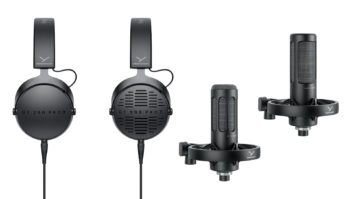
Kosmos Pro is an expanded version of Peavey’s original Kosmossubharmonic enhancement system. Now with +4dB electronically balancedXLR I/Os and S/PDIF digital I/O, Kosmos Pro makes its entrée as atruly professional all-analog unit with control over four processes,including a subharmonic synthesizer called Quake; Thud, a low-frequency“sculpture” tool; a high-frequency and stereo imageenhancer named Xpanse; and Stratos, a dynamic HF effect. I tried KosmosPro on drums, bass, guitars and full mixes with excellent results— results not achievable by any combination of existing analogprocessors.
UP AND DOWN KOSMOS PRO
Internal construction is good with surface-mount components, a THATVCA chip for dynamics processing, internal AC power supply and aCrystal Semiconductor chip set for the S/PDIF I/O. The S/PDIF I/Oparallels the analog connections and locks to incoming digital feeds upto 48 kHz.
Front-panel controls include a Global Bypass button, a switchableLED meter and two input/output level pots (center detented at unitygain). The pots feel a bit flimsy, but are noise-free and work well.Each provides up to 10 dB of extra output level.
A “Cut Sub-Bass From Main” button splits all LFenhancements from the stereo output and routes it to a mono subwooferjack (¼-inch TRS). This feature separates a stereo signal’s normalbass content for recording just the subharmonic effect to a separatetrack. This output is distortion-free, with plenty of level and widedynamics.
IN THE STUDIO
The Quake control sets the level of a synthesized bass signal oneoctave lower than the input source. This signal tracks the inputdynamically and operates within a defined range, up to about 100 Hz.The active LED indicates the presence of usable source information.Quake works well on kick drums, tom tom tracks, and overhead and roommics. I connected the unit on a stereo send and return as I would areverb, so that I could set different amounts on a multitracked drumkit. With this unit in your rack, there is no excuse for thin-soundingkicks and toms. I especially liked pumping up the low end of drum roommics. Kosmos offers good, clean subharmonics: There is no mistracking,and it is quiet and clean.
The Dynamics control could be thought of as a damping adjustmentthat controls the envelope release time of the synthesized Quakesignal. You can go from a tight, fast-responding subsonic signal to alooser, boomier-sounding effect. On kick drum, I adjusted the subnote’s “hang time” with Dynamics. On a solo acousticguitar, using Quake with longer Dynamic settings is like adding a bassplayer: Every time my guitar player made a percussive“thump,” an octave-lower note was produced.
Thud is like a multiband compressor that tracks the input signal anddynamically boosts a band of frequencies from 100 Hz to 350 Hz. Itoperates at roughly an octave above Quake’s output (i.e., the source’soriginal octave). Both Quake and Thud processors’ outputs arephase-coherent. Thud was useful on a thin-sounding acoustic guitartrack when adding an octave wasn’t appropriate. Thud acts like adynamic bass EQ and is good for instruments and vocals. The Deeperbutton changes the center frequency range of Thud to narrow thefrequency difference between it and Quake.
Xpanse is a collection of stereo filters that dynamically modulatesphase, time and frequency domains. However, according to Peavey’s LloydTrammell, “The phase shift angle of the left/right channels doesnot change by the same amount; it may be a +3° shift on the left,while the right has a -7° shift. It depends on the input signal’sfrequency content and amplitude.” A Barometrics knob controls therange of frequencies that Xpanse works on. At the counterclockwiseDense position, it works on the widest range for maximum phasemanipulation, while at the clockwise Thin setting, Xpanse acts on amuch smaller range with less phase manipulation, sounding more like aspecial high-end boost.
I tried Xpanse on an acoustic guitar recorded with two mics on twotracks. Normally, when these two tracks are panned hard left/right,this recording sounds like a wide mono guitar track. Using Xpanseproduced a wide stereophonic effect, and when collapsed down to mono,it revealed some phase cancellation, mostly a small reduction of lowfrequencies.
On bass guitar recorded on two tracks (DI and amp), Xpanse produceda stereo bass, with a superwide footprint that you have to hear tobelieve. Xpanse also works well on drum overheads or most stereo pairs,throwing the left/right channels outside the edges of the speakers.Meanwhile, turning the Barometrics knob toward Thin brightenedeverything, reducing the width.
Stratos adds high frequencies above Xpanse’s range, using modifiedTransTube technology from Peavey’s guitar amp line. Stratos was apleasant-sounding, superhigh “air” EQ that was especiallyuseful on acoustic guitar tracks. Stratos is also dynamic, so there’slittle boost in track hiss and noise, like a regular EQ would haveadded.
I highly recommend Kosmos Pro. Far from being a “one-trickpony,” this is a valuable recording, mixing and live sound toolwith four unique, easy-to-use processors. It’s versatile and a bargainat $599.
Peavey Electronics, 601/483-5365, www.peavey.com.
Barry Rudolph (www.barryrudolph.com) is an L.A.-based recordingengineer.







